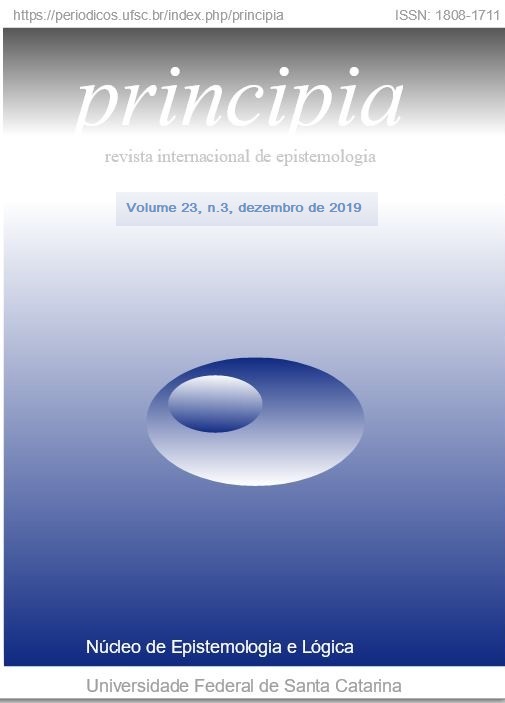Compressibility and the Algorithmic Theory of Laws
DOI:
https://doi.org/10.5007/1808-1711.2019v23n3p461Abstract
The algorithmic theory of laws claims that the laws of nature are the algorithms in the best possible compression of all empirical data. This position assumes that the universe is compressible and that data received from observing it is easily reproducible using a simple set of rules. However, there are three sources of evidence that suggest that the universe as a whole is incompressible. The first comes from the practice of science. The other two come from the nature of the universe itself: the presence of chaotic behavior and the nature of quantum systems also suggests that the universe is incompressible. This paper evaluates these sources and argues that none provides a convincing case to reject the algorithmic theory of laws.
References
Adriaans, P. & van Benthem, J. 2008. Information is What Information Does. In: The Philosophy of Information, p. 7-31. Amsterdam: Elsevier.
Armstrong, D. 1983. What is a Law of Nature? Cambridge: Cambridge University Press.
Artacho, F. 2012. 100 billion step walk on the digits of pi. https://gigapan.com/gigapans/106803. Access: 04/06/2019.
Barrow, J. 1991. Theories of Everything. Oxford: Oxford University Press.
Bell, J. 1964. On the Einstein Podolsky Rosen Paradox. Physics 1: 195-200.
Bird, A. 2008. The Epistemological Argument Against Lewis’s Regularity View of Laws. Philosophical Studies 138: 73-89.
Braddon-Mitchell, D. 2001. Lossy Laws. Nous, 35(2): 260-277.
Calude, C. 2004. Algorithmic Randomness, Quantum Physics and Incompleteness. In: M, Margenstern (ed.), Proceedings of the 4th International Conference on Machines Computations, and Universality, p. 1-17. Berlin: Springer.
Cattaneo, G.; Finelli, M. & Margara, L. 2001. Investigating Topological Chaos by Elementary Cellular Automata Dynamics. Theoretical Computer Science 244 (2000): 219-241.
Chaitin, G. 1987. Algorithmic Information Theory. Cambridge: Cambridge University Press.
Chaitin, G. 2005. Meta Maths - The Quest for Omega. London: Atlanta Books.
Coombes, S. 2009. The Geometry and Pigmentation of Seashells. Nottingham: Department of Mathematical Sciences, University of Nottingham.
Davies, P. 1995. Algorithmic Compressibility, Fundamental and Phenomenological Laws. In: F. Weinert (ed.), Laws of Nature: Essays on the Philosophical, Scientific and Historical Dimensions, p. 248-267. Berlin: Walter de Gruyter & Co.
Feynman, R. 1963. Lectures on Physics (Vol. 1). Reading: Addison-Wesley.
Floridi, L. 2010. Information: A Very Short Introduction. Oxford: Oxford University Press.
Gell-Mann, M. 1987. Simplicity and Complexity in the Description of Nature. Talk Delivered to The Caltech Associates, Pasadena 01/10/987.
Grünwald, P. & Vitanyi, P. 2008. Algorithmic Complexity. In: P. Adriaans & J. van Benthem (eds.), Philosophy of Information, p. 289-328. Amsterdam: Elsevier.
Hall, N. 1992. Introduction. In: The New Scientist Guide to Chaos, p. 7-10. London: Penguin.
Kolmogorov, A. 1965. Three Approaches to the Definition of the Quantity of Information. Problems of Information Transmission, 1(1): 1-7.
Landauer, R. 1996. The Physical Nature of information. Physics Letters A, 217: 188-193.
Lewis, D. 1973. Counterfactuals. Oxford: Blackwell.
Lewis, D. 1983. New Work for a Theory of Universals. Australasian Journal of Philosophy, 61(4): 343-377.
Lewis, D. 1986. Philosophical Papers Volume II. Oxford: Oxford University Press.
Lewis, D. 1994. Humean Supervenience Debugged. Mind 103(412): 473-490.
Lloyd, S. 2006. Programming the Universe: A Quantum Computer Scientist takes on the Cosmos. New York: Alfred Knopf.
Luminet, J.; Weeks, J.; Riazuelo, A.; Lehouq, R. & Uzan, J. 2003. "Dodecahedral space topology as an explanation for weak wide-angle temperature correlations in the cosmic microwave background." Nature 425: 593-595.
Mach, E. 1894. Popular Scientific Lectures. Illinois: Open Court.
Mandelbrot, B. 1977. The Fractal Geometry of Nature. New York: W. H. Freeman and Company.
Mandelbrot, B. 1992. Fractals - a Geometry of Nature. In: N Hall (ed.), The New Scientist Guide to Chaos, p. 122-135. London: Penguin.
McAllister, J. 2003. Algorithmic Randomness in Empirical Data. Studies in the History and Philosophy of Science 34 (3): 633-646.
McAllister, J. 2005. Algorithmic Compression of Empirical Data: Reply to Twardy, Gardner and Dowe. Studies in the History and Philosophy of Science 36 (2): 403-410.
Packard, A. 2001. A ‘Neural’ Net that Can Be Seen with the Naked Eye. In: W. Backhaus (ed.), Neuronal Coding of Perceptual Systems, p. 397-402. London: World Scientific.
Peak, D.; West, J.; Messinger, S. & Mott, K. 2003. Evidence for complex, collective dynamics and emergent, distributed computation in plants. Proceedings of the National Academy of Sciences of the United States of America 101 (4): 918–922.
Shannon, C, and W Weaver. 1949. The Mathematical Theory of Information. Chicago: University of Illinois Press.
Solomonoff, R. 1964. A Formal Theory of Inductive Inference: Part I. Information and Control 7(1): 1-22.
‘T Hooft, G. 2016. The Cellular Automaton Interpretation of Quantum Mechanics. Heldelberg: Springer.
Tomkow, T. 2013. The Computational Theory of the Laws of Nature. http://tomkow.typepad.com/tomkowcom/2013/09/the-computational-theory-of-natural-laws.html. Access: 08/06/2019.
Twardy, C.; Gardner, S. & Dowe, D. 2005. Empirical Data Sets are Algorithmically Compressible: Reply to McAllister? Studies in the History and Philosophy of Science 36 (2): 391-402.
van Benthem, J. & Martinez. M. 2008. The Stories of Logic and Information. In: P. Adriaans & J. van Benthem (eds.) The Philosophy of Information, p. 255-288. Amsterdam: Elsevier.
van Fraassen, B. 1980. The Scientific Image. Oxford: Clarenden Press.
Wallace, C. & Boulton, D. 1968. An information Measure for Classification. Computer Journal 11 (2): 185–194.
Wheeler, B. 2016. Simplicity, Language-Dependency and the Best System Account of Laws. Theoria: An International Journal for Theory, History and Foundations of Science 31(2): 189-206.
Wheeler, B. 2017. Humeanism and Exceptions in the Fundamental Laws of Physics. Principia: An International Journal of Epistemology 21(3): 317–337.
Wheeler, B. 2018. Idealization and the Laws of Nature. Geneva: Springer.
Wolfram, S. 2002. A New Kind of Science. Champaign: Wolfram Media.
Yurtsever, U. 2000. Quantum Mechanics and Algorithmic Randomness. Complexity 6 (1): 27–34.
Downloads
Published
Issue
Section
License

Principia http://www.periodicos.ufsc.br/index.php/principia/index is licenced under a Creative Commons - Atribuição-Uso Não-Comercial-Não a obras derivadas 3.0 Unported.
Base available in www.periodicos.ufsc.br.



